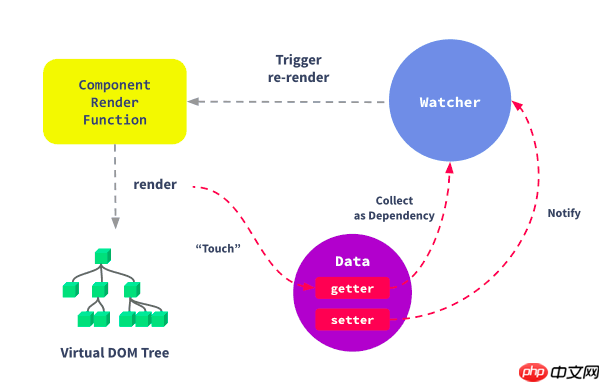Vue中computed的實作原理是什麼?
- 不言原創
- 2018-09-14 16:10:064019瀏覽
雖然目前的技術堆疊已由Vue 轉到了React,但從之前使用Vue 開發的多個專案實際經歷來看還是非常愉悅的,Vue 文檔清晰規範,api 設計簡潔高效,對前端開發人員友好,上手快,甚至個人認為在很多場景使用Vue 比React 開發效率更高,之前也有斷斷續續研讀過Vue 的源碼,但一直沒有梳理總結,所以在此做一些技術歸納同時也加深自己對Vue 的理解,那麼今天要寫的便是Vue 中最常用到的API 之一computed 的實作原理。
基本介紹
話不多說,一個最基本的例子如下:
<div>
<p>{{fullName}}</p>
</div>
new Vue({
data: {
firstName: 'Xiao',
lastName: 'Ming'
},
computed: {
fullName: function () {
return this.firstName + ' ' + this.lastName
}
}
})
Vue 中我們不需要在template 裡面直接計算{{this. firstName ' ' this.lastName}},因為在模版中放入太多宣告式的邏輯會讓模板本身過重,尤其當在頁面中使用大量複雜的邏輯表達式處理資料時,會對頁面的可維護性造成很大的影響,而computed 的設計初衷也正是用來解決這類問題。
對比偵聽器watch
當然很多時候我們使用computed 時往往會與Vue 中另一個API 也就是偵聽器watch 比較,因為在某些方面它們是一致的,都是以Vue 的依賴追蹤機制為基礎,當某個依賴資料發生變化時,所有依賴這個資料的相關資料或函數都會自動發生變化或調用。
watch 選項提供了一個更通用的方法來回應資料的變化。當需要在資料變更時執行非同步或開銷較大的操作時,這個方式是最有用的。 從Vue 官方文件對watch 的解釋我們可以了解到,使用 watch 選項允許我們執行非同步操作(存取一個API)或高消耗效能的操作,限制我們執行該操作的頻率,並在我們得到最終結果之前,設定中間狀態,而這些都是計算屬性無法做到的。
下面也總結了幾點關於computed 和watch 的差異:
##computed
是計算一個新的屬性,並將該屬性掛載到vm(Vue 實例)上,而watch是監聽已經存在且已掛載到vm上的數據,所以用watch同樣可以監聽computed計算屬性的變化(其它還有data、props)computed
基本上是一個惰性求值的觀察者,具有快取性,只有當依賴變更後,第一次存取computed屬性,才會計算新的值,而watch則是當資料發生變化便會呼叫執行函數- 從使用場景上說,
computed
適用一個資料被多個資料影響,而watch適用一個資料影響多個資料;##以上我們了解了
和watch 之間的一些差異和使用場景的區別,當然某些時候兩者並沒有那麼明確嚴格的限制,最後還是要具體到不同的業務進行分析。 原理分析
言歸正傳,回到文章的主題
computed 身上,為了更深層地了解計算屬性的內在機制,接下來就讓我們一步一步探索Vue源碼中關於它的實作原理吧。 在分析
原始碼之前我們先得對Vue 的響應式系統有一個基本的了解,Vue 稱其為非侵入性的響應式系統,資料模型僅僅是普通的JavaScript 對象,而當你修改它們時,視圖就會進行自動更新。
 當你把一個普通的JavaScript 物件傳給Vue 實例的data
當你把一個普通的JavaScript 物件傳給Vue 實例的data
Object.defineProperty 把這些屬性全部轉為getter/setter,這些getter/setter 對使用者來說是不可見的,但是在內部它們讓Vue 追蹤依賴,在屬性被存取和修改時通知變化,每個元件實例都有對應的watcher 實例對象,它會在元件渲染的過程中把屬性記錄為依賴,之後當依賴項的setter 被呼叫時,會通知watcher 重新計算,從而致使它關聯的元件得以更新。 Vue 回應系統,其核心有三點:observe、watcher、dep:<ol class=" list-paddingleft-2">
<li><p><code>observe:遍历 data 中的属性,使用 Object.defineProperty 的 get/set 方法对其进行数据劫持;
dep:每个属性拥有自己的消息订阅器 dep,用于存放所有订阅了该属性的观察者对象;
watcher:观察者(对象),通过 dep 实现对响应属性的监听,监听到结果后,主动触发自己的回调进行响应。
对响应式系统有一个初步了解后,我们再来分析计算属性。
首先我们找到计算属性的初始化是在 src/core/instance/state.js 文件中的 initState 函数中完成的
export function initState (vm: Component) {
vm._watchers = []
const opts = vm.$options
if (opts.props) initProps(vm, opts.props)
if (opts.methods) initMethods(vm, opts.methods)
if (opts.data) {
initData(vm)
} else {
observe(vm._data = {}, true /* asRootData */)
}
// computed初始化
if (opts.computed) initComputed(vm, opts.computed)
if (opts.watch && opts.watch !== nativeWatch) {
initWatch(vm, opts.watch)
}
}
调用了 initComputed 函数(其前后也分别初始化了 initData 和 initWatch )并传入两个参数 vm 实例和 opt.computed 开发者定义的 computed 选项,转到 initComputed 函数:
const computedWatcherOptions = { computed: true }
function initComputed (vm: Component, computed: Object) {
// $flow-disable-line
const watchers = vm._computedWatchers = Object.create(null)
// computed properties are just getters during SSR
const isSSR = isServerRendering()
for (const key in computed) {
const userDef = computed[key]
const getter = typeof userDef === 'function' ? userDef : userDef.get
if (process.env.NODE_ENV !== 'production' && getter == null) {
warn(
'Getter is missing for computed property "${key}".',
vm
)
}
if (!isSSR) {
// create internal watcher for the computed property.
watchers[key] = new Watcher(
vm,
getter || noop,
noop,
computedWatcherOptions
)
}
// component-defined computed properties are already defined on the
// component prototype. We only need to define computed properties defined
// at instantiation here.
if (!(key in vm)) {
defineComputed(vm, key, userDef)
} else if (process.env.NODE_ENV !== 'production') {
if (key in vm.$data) {
warn('The computed property "${key}" is already defined in data.', vm)
} else if (vm.$options.props && key in vm.$options.props) {
warn('The computed property "${key}" is already defined as a prop.', vm)
}
}
}
}
从这段代码开始我们观察这几部分:
-
获取计算属性的定义
userDef和getter求值函数const userDef = computed[key] const getter = typeof userDef === 'function' ? userDef : userDef.get
定义一个计算属性有两种写法,一种是直接跟一个函数,另一种是添加
set和get方法的对象形式,所以这里首先获取计算属性的定义userDef,再根据userDef的类型获取相应的getter求值函数。 -
计算属性的观察者
watcher和消息订阅器depwatchers[key] = new Watcher( vm, getter || noop, noop, computedWatcherOptions )
这里的
watchers也就是vm._computedWatchers对象的引用,存放了每个计算属性的观察者watcher实例(注:后文中提到的“计算属性的观察者”、“订阅者”和watcher均指代同一个意思但注意和Watcher构造函数区分),Watcher构造函数在实例化时传入了 4 个参数:vm实例、getter求值函数、noop空函数、computedWatcherOptions常量对象(在这里提供给Watcher一个标识{computed:true}项,表明这是一个计算属性而不是非计算属性的观察者,我们来到Watcher构造函数的定义:class Watcher { constructor ( vm: Component, expOrFn: string | Function, cb: Function, options?: ?Object, isRenderWatcher?: boolean ) { if (options) { this.computed = !!options.computed } if (this.computed) { this.value = undefined this.dep = new Dep() } else { this.value = this.get() } } get () { pushTarget(this) let value const vm = this.vm try { value = this.getter.call(vm, vm) } catch (e) { } finally { popTarget() } return value } update () { if (this.computed) { if (this.dep.subs.length === 0) { this.dirty = true } else { this.getAndInvoke(() => { this.dep.notify() }) } } else if (this.sync) { this.run() } else { queueWatcher(this) } } evaluate () { if (this.dirty) { this.value = this.get() this.dirty = false } return this.value } depend () { if (this.dep && Dep.target) { this.dep.depend() } } }为了简洁突出重点,这里我手动去掉了我们暂时不需要关心的代码片段。
观察Watcher的constructor,结合刚才讲到的new Watcher传入的第四个参数{computed:true}知道,对于计算属性而言watcher会执行if条件成立的代码this.dep = new Dep(),而dep也就是创建了该属性的消息订阅器。export default class Dep { static target: ?Watcher; subs: Array<watcher>; constructor () { this.id = uid++ this.subs = [] } addSub (sub: Watcher) { this.subs.push(sub) } depend () { if (Dep.target) { Dep.target.addDep(this) } } notify () { const subs = this.subs.slice() for (let i = 0, l = subs.length; i <p><code>Dep</code> 同样精简了部分代码,我们观察 <code>Watcher</code> 和 <code>Dep</code> 的关系,用一句话总结</p> <blockquote> <code>watcher</code> 中实例化了 <code>dep</code> 并向 <code>dep.subs</code> 中添加了订阅者,<code>dep</code> 通过 <code>notify</code> 遍历了 <code>dep.subs</code> 通知每个 <code>watcher</code> 更新。</blockquote></watcher> -
defineComputed定义计算属性if (!(key in vm)) { defineComputed(vm, key, userDef) } else if (process.env.NODE_ENV !== 'production') { if (key in vm.$data) { warn('The computed property "${key}" is already defined in data.', vm) } else if (vm.$options.props && key in vm.$options.props) { warn('The computed property "${key}" is already defined as a prop.', vm) } }因为
computed属性是直接挂载到实例对象中的,所以在定义之前需要判断对象中是否已经存在重名的属性,defineComputed传入了三个参数:vm实例、计算属性的key以及userDef计算属性的定义(对象或函数)。
然后继续找到defineComputed定义处:export function defineComputed ( target: any, key: string, userDef: Object | Function ) { const shouldCache = !isServerRendering() if (typeof userDef === 'function') { sharedPropertyDefinition.get = shouldCache ? createComputedGetter(key) : userDef sharedPropertyDefinition.set = noop } else { sharedPropertyDefinition.get = userDef.get ? shouldCache && userDef.cache !== false ? createComputedGetter(key) : userDef.get : noop sharedPropertyDefinition.set = userDef.set ? userDef.set : noop } if (process.env.NODE_ENV !== 'production' && sharedPropertyDefinition.set === noop) { sharedPropertyDefinition.set = function () { warn( 'Computed property "${key}" was assigned to but it has no setter.', this ) } } Object.defineProperty(target, key, sharedPropertyDefinition) }在这段代码的最后调用了原生
Object.defineProperty方法,其中传入的第三个参数是属性描述符sharedPropertyDefinition,初始化为:const sharedPropertyDefinition = { enumerable: true, configurable: true, get: noop, set: noop }随后根据
Object.defineProperty前面的代码可以看到sharedPropertyDefinition的get/set方法在经过userDef和shouldCache等多重判断后被重写,当非服务端渲染时,sharedPropertyDefinition的get函数也就是createComputedGetter(key)的结果,我们找到createComputedGetter函数调用结果并最终改写sharedPropertyDefinition大致呈现如下:sharedPropertyDefinition = { enumerable: true, configurable: true, get: function computedGetter () { const watcher = this._computedWatchers && this._computedWatchers[key] if (watcher) { watcher.depend() return watcher.evaluate() } }, set: userDef.set || noop }当计算属性被调用时便会执行
get访问函数,从而关联上观察者对象watcher然后执行wather.depend()收集依赖和watcher.evaluate()计算求值。
分析完所有步驟,我們再來總結下整個流程:
當元件初始化的時候,
computed和data會分別建立各自的回應系統,Observer遍歷data中每個屬性設定get/set資料攔截#初始化computed會呼叫initComputed函數- ##註冊一個
watcher
或其他觀察該計算屬性變化的實例,並在內實例化一個Dep訊息訂閱器用作後續收集依賴(例如渲染函數的watcher watcher - )
呼叫計算屬性時會觸發其Object.defineProperty的get存取器函數 watcher.depend()方法將其他屬性的watcher- watcher
的
propsevaluate方法(進而呼叫watcher的get方法)讓自己成為其他watcher的訊息訂閱器的訂閱者,首先將watcher賦給Dep.target,然後執行getter求值函數,當存取求值函數裡面的屬性(例如來自data、 或其他
)時,會同樣觸發它們的
get 存取器函數從而將該計算屬性的watcher 加到求值函數中屬性的
watcher
dep 中,當這些操作完成,最後關閉 Dep.target
賦為null
並傳回求值函數結果。 ###############當某個屬性發生變化,觸發###set### 攔截函數,然後呼叫自身訊息訂閱器###dep### 的### notify### 方法,遍歷目前###dep### 中保存著所有訂閱者###wathcer### 的###subs### 數組,並逐一呼叫###watcher### 的 # ##update### 方法,完成回應更新。 ############相關推薦:#########javascript - 刷票器的實作原則###############thinkphp 控制器中display()步驟實作的原理############以上是Vue中computed的實作原理是什麼?的詳細內容。更多資訊請關注PHP中文網其他相關文章!

